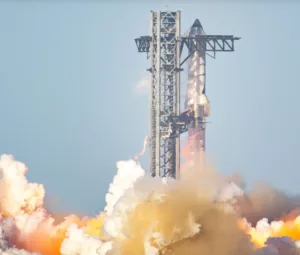SpaceX’s Starship, the most powerful rocket ever built, experienced another mid-flight explosion during its eighth test flight on Thursday. This marks the second consecutive failure for the spacecraft this year, causing significant disruptions to air traffic in Florida and raising questions about safety protocols.
What Happened During the Launch?
The uncrewed Starship mission lifted off at 5:30 p.m. The spacecraft was mounted atop a 232-foot-tall Super Heavy rocket booster, aiming to reach space.
- Initial Success: The Super Heavy booster separated as planned after 2.5 minutes, successfully landing on SpaceX’s launch tower.
- Mid-Flight Failure: Less than 10 minutes into the flight, the Starship began experiencing engine failures, leading to a loss of control and communication.
- Explosion: The spacecraft exploded over the Atlantic, with debris visible from parts of Florida and the Caribbean.
Air Traffic Disruptions
The explosion caused significant disruptions to air traffic in Florida. The Federal Aviation Administration (FAA) temporarily halted flights into several major airports, including Miami, Fort Lauderdale, Palm Beach, and Orlando, due to concerns about falling debris.
- Flight Delays: Departures from Fort Lauderdale and Miami airports were delayed by 30 to 45 minutes.
- Safety Measures: SpaceX assured the public that debris response areas and safety protocols were in place to minimize risks.
SpaceX’s Response
SpaceX released a statement hours after the incident, providing some details about the failure:
- Engine Failure: An “energetic event” in the rear section of Starship caused the loss of several Raptor engines, leading to a loss of control.
- Debris Management: SpaceX confirmed that any surviving debris fell within a pre-planned response area, posing no toxic risks to marine life or water quality.
- Hotline for Debris: The company urged anyone who finds debris to contact local authorities or SpaceX’s debris hotline.
FAA Investigation
The FAA has mandated a mishap investigation to determine the root cause of the explosion and ensure public safety.
- Investigation Goals: The probe will identify corrective actions to prevent future incidents.
- Return to Flight: SpaceX must receive FAA approval before attempting another launch.
Comparison to Previous Failures
This incident follows a similar explosion during Starship’s seventh test flight in January, which rained debris over the Turks and Caicos islands.
- Key Differences: Unlike previous failures, this explosion occurred over the Atlantic, raising concerns about launching experimental rockets near populated areas.
- Ongoing Concerns: Residents of Turks and Caicos are still finding debris from the January incident, highlighting the long-term impact of such failures.
Upgrades and Future Plans
Despite the setbacks, SpaceX continues to refine Starship’s design and systems.
- Heat Shield Testing: Engineers removed heat shield tiles to test vulnerable areas.
- System Upgrades: Changes include new vents, a purge system, and adjustments to fuel lines and engine thrust targets.
- Mock Satellite Deployment: The mission aimed to deploy mock Starlink satellites, but the explosion prevented this objective.
Why These Incidents Matter
SpaceX’s “rapid iterative development” philosophy involves testing prototypes quickly, even if it means risking explosions. However, the recent incidents raise questions about safety and regulatory oversight.
- Public Safety: The FAA’s decision to allow another launch before completing the investigation into the January failure has drawn criticism.
- Environmental Impact: Debris from the explosions continues to affect local communities and ecosystems.
SpaceX Starship Program
While SpaceX’s ambitious Starship program aims to revolutionize space travel, the repeated failures highlight the challenges of developing such advanced technology. As investigations continue, the focus remains on ensuring public safety and minimizing environmental impact.
References:
















